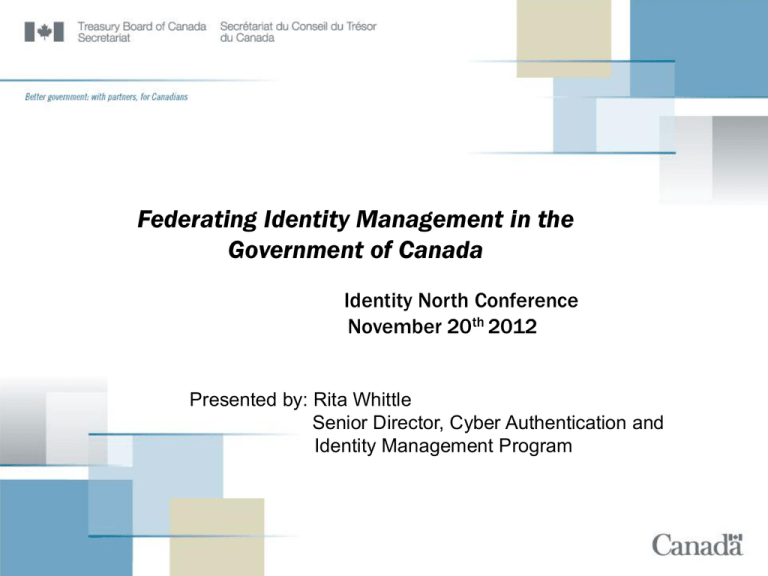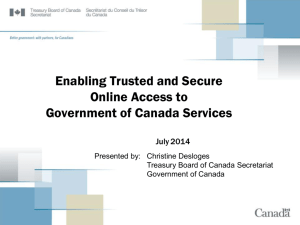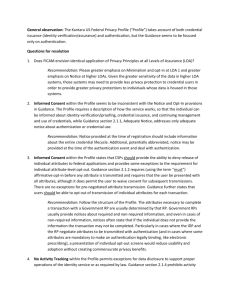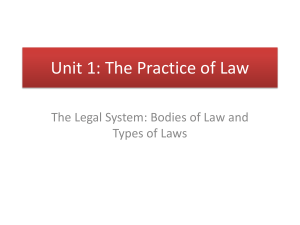Government of Canada Federating Identity
advertisement

Federating Identity Management in the Government of Canada Identity North Conference November 20th 2012 Presented by: Rita Whittle Senior Director, Cyber Authentication and Identity Management Program Government of Canada Context Speech from the Throne and Budget 2012 Citizen-focused service delivery - Improve services and service delivery to Canadians at a lower cost Standardize, consolidate and re-engineer the way the GC does business Whole-of-government approach: Modernize the way we work and serve Canadians in an increasingly horizontal and collaborative world Expectations of Clients Seamless, secure, e-enabled delivery channels Better, faster and more convenient access to government services Ability to interact seamlessly with multiple governments, through multiple channels 2 . . . Government of Canada Context Payments Review Task Force Report “A robust digital ID regime is one where identification is accomplished without paper documents or face-to-face visits, and in a way that protects sensitive information and the privacy of the individual.” Called for the creation of a Canadian Digital ID and Authentication Council (DIAC) which is now in place Becoming a Digital Nation (reference: Stratford Institute, 04/2012) Increase Canada’s performance through digital technologies Facilitate the transition to digital services, digital payments and digital identity Trusting identities across jurisdictions must be solved using a pan-Canadian approach 3 Identity is the Starting Point for Services, Benefits and Entitlements High value services Today, identity is managed separately by each department, jurisdiction and sector… Financial Sector Public Sector Who are you? Who are you? Who are you? How will you pay? Are you eligible for a government benefit? What is your medical history? Identity risks ! Healthcare Sector Identity risks translate into: translate into: ! Sector Issues Sector Issues •Financial fraud •Money laundering •Higher transaction fees Identity risks ! •Benefits fraud •Longer processing times •Redundant processes translate into: Sector Issues •Prescription fraud •Patient Privacy •Record integrity … but the impacts are felt by everyone 4 Vision: Pan-Canadian Approach Collaborative effort between jurisdictions and sectors Principles: Respect privacy Client choice Governments have a key role to play Collaborate with trusted private sector institutions Phased approach to evolving services and infrastructure Federated Approach Trusting credentials and identities: •Across jurisdictions •Across sectors •Internationally Federating Credentials Federating Identity ‘trusting credentials issued by other jurisdictions and industry sectors’ ‘trusting identities that have been established by other jurisdictions’ 5 Identity Context Identity information is required for valued transactions It is the starting point of management of interactions and transactions (initial and ongoing) in all sectors, necessary for service provisioning, determining access, granting of benefits and entitlements, etc. Risk related to identity information impacts the immediate interaction/transaction and can impact other downstream activities Identity information exists and is managed across orders of government Digital Identity is becoming increasingly important Financial and social interactions are becoming digital Necessary for transition to online channel, advancing the digital economy of Canada Key to Integrating processes across organizations and jurisdictions Must align with international trends Identity theft and fraud Speed of fraud in cyberspace vs. in the physical world Criminal element has moved online 6 Evolution to Federating Identity Federating Credentials Federating Identity GC Approach Pan-Canadian Approach Cyber Authentication Service GC Identity Federation Service Identity Federation Service Mandatory Services Pilot Projects Federation Enablers Commercial GC Issued GC Identity Assurance Service GC Identity Validation Service Other jurisdictions Identity Services Identity Federation Services Credential Federation Services Policy Enablers Legislative Enablers Standards-based Standards-based Standards-based Federation Federation Federation Multiple Recognized Providers Multiple Credential Options Multiple Levels of Assurance GC Identity Validation Service Identity Business & Technical Architecture DIAC Governance Commercial Services Multiple Authoritative Identity Sources 7 Strategic Relationships Inter-jurisdictional: Joint Councils – Public Sector Service Delivery Council and Public Sector CIO Council Identity Management Sub-Committee (IMSC) Composition: Federal, Provincial, Territorial, Municipal International Dialogues Other governments - United States, Australia, New Zealand, U.K. Kantara Initiative ICA (International Council for Information Technology in Government Administration) Digital ID and Authentication Council (DIAC) Public and private sector forum recommended by the Task Force for Payments System Review Mandated to develop pan-Canadian approach to digital ID and authentication and facilitate development of interoperable policies, standards and systems Composition: Independent Chair (private industry); Government Representatives; Industry Representatives (telecommunications, banks, health); Independent Representatives 8 Cyber Authentication Renewal Strategy Transformative “federation of credentials” approach First major step enabling transformative online service delivery Lays foundation for evolving relationships with other jurisdictions and the private sector Credentials issued by service providers other than the GC can be trusted to access online government services = Choice of Credentials Provides cost-effective, standards based solution Respects Clients’ Privacy Fundamental design of GC Cyber Authentication Renewal driven by privacy policy considerations Distinction maintained between assurance of credential and assurance of identity – the “anonymous credential” ensures privacy is respected Authentication service provides assurance that the same individual is accessing an online service, but does not reveal the identity of the individual (the “persistent anonymous identifier”) Identity only associated to credential during program enrolment within individual department domain 9 Choice of Credentials Credential Broker Service - An innovative relationship with private sector SecureKey Concierge operational since April 2012 - Enables log in to GC online services using commercially available credentials (currently three Canadian financial institutions: Scotiabank, TD, BMO) Leverages the investments made in security and infrastructure in the private sector To respect privacy, minimal and non-personally identifiable information is managed and used through Credential Broker Service Positions the GC to benefit from ongoing industry investments in evolving and strengthening assurance levels GC Key Service – Provides option to use a GC credential Ensures all GC clients have ability to log in to e-services Implementation is currently underway by GC departments 10 Identity Management: Strategy-in-Brief GC’s strategy on identity management is based on a federated approach using the following principles: Give choices to citizens and businesses to decide on how they want to identify themselves to receive services Enable a “tell us once” strategy by allowing the re-use of personal identity information across multiple service delivery channels Ensure the integrity of the information through validation from trusted (authoritative) sources of identity information Establish interoperability standards Partner with other jurisdictions and the private sector to deliver solutions Promote a fair and equitable competitive market place Policy instruments to support federating identity in the GC are currently under development (standard and guidelines) 11 Moving Forward TBS is leading discussions on federating identity within the GC, building on solid cyber authentication base Open to future enhancements Flexible in meeting GC program needs Providing client choice Privacy central to any plans for federating identity going forward Policy positions will be evolved through continuing engagement and consultation with GC departments Discussions underway with GC departments to explore suitable candidates for e-validation pilot projects – one for individuals, one for businesses Will inform the broader GC federating identity strategy moving forward – demonstrating business value and technical feasibility – identifying potential policy and legislative considerations Continuing analysis underway 12 Questions and Discussion 13










